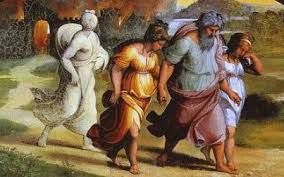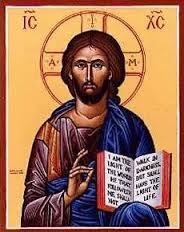Last April, my family moved to Eugene, Oregon. Eugene is located in Linn County. This is all you need to know that important fact:
Linn County is the “Grass Seed Capital of the [FREAKIN] World.”
Guess who is allergic grass seed? Yeah, that’s right. Me. My face has been a hideous mess of goopy sludge emanating from my nose and eyes.
I’ve tried everything soothe my pain. Claritin. Allegra. Zyrtec. Nothing worked. The only thing that provided any relief were frozen blueberry waffles:
So, I decided I needed allergy shots. In addition to this being the summer of the merciless grass seed, it’s also been the summer of Daddy-Day-Care at the Ericksen house. So, when I went to my first appointment, I took my three children with me.
Childhood Games and a Violent God
As we sat in the waiting room, my boys decided to play Rock, Paper, Scissors. At ages 7 and 6, they have become very skilled, so I recently decided to introduce them to the ultimate weapon – dynamite. Dynamite is made just like the rock, only you lift up your thumb to create the fuse. With the colossal “BOOM!” sound effect, dynamite utterly destroys rock, paper, and scissors.
At least, it used to be the ultimate weapon of destruction. While waiting for my shots, my oldest boy came up with an ever more destructive weapon – God.

After a few rounds of the game, he activated the omnipotent God weapon. When he did, all hell broke loose. “Rock, paper, scissors … GOD!” he yelled. Then he lifted both hands high in the air and violently threw them down with the thunderous sound of hell-fire and brimstone on top of his younger brother.
God. The Destroyer.
I know it’s just a game, but as the good mimetic theorist that I am, I’ve spent their young lives trying to teach them that God isn’t like that. As First John teaches us, I try to teach them that, “God is light and in him there is no darkness at all.” No darkness. No violence. Only love. We are the Destroyers. We are the ones who rain down hell-fire and brimstone upon one another. God doesn’t do that.
Biblical Violence
Of course, many people will point to passages in scripture where God does rain down hell-fire and brimstone upon people. Take, for example, the famous story of Sodom and Gomorrah in Genesis 19. All you need is this one verse to justify a violent God: “Then the Lord rained on Sodom and Gomorrah sulfur and fire from the Lord out of heaven.”
I remember learning that story, and many others like it, in Sunday school. Without any qualms or hesitation, I was taught that God nearly destroyed the whole earth though a flood and that God destroyed Sodom and Gomorrah through fire. The Bible is full of violence, both human and divine. This really shouldn’t surprise us. After all, we moderns don’t have a good track record with violence. Whether we justify our violence in the name of God or national security or freedom or whatever, the outcome is always the same violent destruction.
 Still, we moderns like to critique the Bible for its violence, but the truth is that the Bible provides a huge leap forward in the human understanding of the relationship between violence and the divine. After all, if you look at other ancient myths, the gods of all religions were violent. In fact, the gods of Babylon, Rome, and Greece were not only violent, but also fickle. You never knew what would send those gods into a violent rage. Take the Babylonian flood story, for example. The Babylonian gods destroyed the world with a flood because humans were being too noisy, causing the gods to lose sleep. The biblical flood story is horrific, but it’s a huge step forward in the human understanding of the divine. In the biblical story, God’s problem wasn’t with human noise causing God to lose sleep; it was with humans causing violence, death, and destruction. And, as terrible as the destruction of Sodom and Gomorrah was, we can say something similar about that story. God’s problem with those nations was that they refused to show hospitality to strangers and to aid the poor and needy members of their society.
Still, we moderns like to critique the Bible for its violence, but the truth is that the Bible provides a huge leap forward in the human understanding of the relationship between violence and the divine. After all, if you look at other ancient myths, the gods of all religions were violent. In fact, the gods of Babylon, Rome, and Greece were not only violent, but also fickle. You never knew what would send those gods into a violent rage. Take the Babylonian flood story, for example. The Babylonian gods destroyed the world with a flood because humans were being too noisy, causing the gods to lose sleep. The biblical flood story is horrific, but it’s a huge step forward in the human understanding of the divine. In the biblical story, God’s problem wasn’t with human noise causing God to lose sleep; it was with humans causing violence, death, and destruction. And, as terrible as the destruction of Sodom and Gomorrah was, we can say something similar about that story. God’s problem with those nations was that they refused to show hospitality to strangers and to aid the poor and needy members of their society.
The Bible’s Critique of Violence
While those are huge steps forward in the human understanding of the divine, they don’t go far enough. They still claim that God is violent. But the Bible contains a critique of its own violent version of God, and there is no more important story for Christians to claim the nonviolence of God than the story of Jesus.
Jesus, of course, was Jewish and was formed by his religious tradition. But what many modern Christians don’t understand is that within Judaism there have always been multiple interpretations of the Bible. Ancient rabbis had their schools of thought, where they provided instruction on interpreting the Bible.
Jesus, whom Christians claim to be our Rabbi or Teacher*, provided specific instruction for interpreting the Bible, and specifically for how to interpret biblical violence. On multiple occasions, Jesus quoted the prophet Hosea, instructing anyone who would listen to:
“Go and learn what this means, ‘I desire mercy and not sacrifice.’”
In his Adult Education Course entitled Jesus the Forgiving Victim, James Alison claims “This is not just a particular commandment. It is a reading instruction, a hermeneutical key. Whenever you interpret anything, you can read it two ways: in such a way that your interpretation creates mercy, and in such a way that it creates sacrifice…‘Mercy’ and ‘sacrifice’ are not here discrete religious gestures. Each one is an entire anthropology of God’s desire, and they are incompatible with each other.”
The theology behind the violent sacrificial strand within the Bible, such as the Sodom and Gomorrah story, is incompatible with the theology behind the “mercy and not sacrifice” strand within the Bible.
Jesus’ Critique of Sacred Violence
 Not only did Jesus teach that God desires mercy and not sacrifice, he enacted God’s desire for mercy and not sacrifice. For example, Jesus implicitly critiqued the theology of sacred violence behind the Sodom and Gomorrah story when he sent his disciples ahead of him to a Samaritan village. The Samaritans rejected Jesus and his disciples. When James and John, two of Jesus’ disciples, heard this, they channeled the same sacred violence in the Sodom and Gomorrah story. They said to Jesus, “Lord, do you want us to command fire to come down from heaven and consume them?” Jesus, who had been teaching his disciples to love their enemies, which clearly meant they shouldn’t command fire or missiles or bombs to come down from heaven upon their enemies, rebuked his disciples and he simply led them on to the next town.
Not only did Jesus teach that God desires mercy and not sacrifice, he enacted God’s desire for mercy and not sacrifice. For example, Jesus implicitly critiqued the theology of sacred violence behind the Sodom and Gomorrah story when he sent his disciples ahead of him to a Samaritan village. The Samaritans rejected Jesus and his disciples. When James and John, two of Jesus’ disciples, heard this, they channeled the same sacred violence in the Sodom and Gomorrah story. They said to Jesus, “Lord, do you want us to command fire to come down from heaven and consume them?” Jesus, who had been teaching his disciples to love their enemies, which clearly meant they shouldn’t command fire or missiles or bombs to come down from heaven upon their enemies, rebuked his disciples and he simply led them on to the next town.
Notice that the disciples had an interpretative lens of sacrificial violence, not mercy. In rebuking his disciples, Jesus rebuked the whole idea of sacred violence; the idea that God has anything to do with violence.
Jesus said, “Let the little children come to me.” Before we take our children to stories depicting sacred violence, such as the flood and Sodom and Gomorrah, we need to take them to Jesus. Jesus saves the world not through sacrificial violence, but through merciful love. The disciples mistakenly thought they could achieve God’s purposes through sacrificial violence. Unfortunately, we continue to make this mistake today, and we unwittingly indoctrinate our children into that same theological mistake. And pretty soon they start dropping the God hand in Rock, Paper, Scissors!
Yet, Jesus calls us to follow him, to “go and learn what this means, ‘I desire mercy and not sacrifice.” With that teaching Jesus, and the prophet Hosea before him, critiqued sacrificial violence. With his merciful life, death, and resurrection, Jesus offered forgiveness to break the cycle of violence and he revealed the nonviolent love of God that reaches out to all people.













